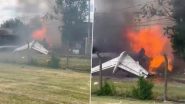Washington [US], August 18 (ANI): The US intelligence community believes that Ukraine's counteroffensive won't succeed in reaching the important southeastern city of Melitopol. If this assessment turns out to be accurate, Kyiv won't achieve its main goal of severing Russia's land bridge to Crimea in this year's push, The Washington Post reported.
The assessment is based on Russia's brutal proficiency in defending occupied territory through a phalanx of minefields and trenches, and it's likely to lead to finger-pointing in Kyiv and Western capitals over why a counteroffensive that involved tens of billions of dollars worth of weapons and military hardware from the West failed to achieve its objectives.
US officials stated that the Ukrainian forces, which are approaching Melitopol from the town of Robotyne, more than 50 miles away, will stay a distance away from the city.
In order to discuss classified military activities, The Washington Post interviewed US, Western, and Ukrainian government officials under the condition of anonymity.
The US Directorate of National Intelligence declined to make any comments.
Since Melitopol is regarded as the entry point to Crimea, it is essential to Ukraine's counteroffensive. Two significant highways, a railway line, and the city's location at their intersection allow Russia to transport military soldiers and equipment from the peninsula to other seized areas in southern Ukraine.
US officials predict that Ukraine's attempt to reclaim Russian-occupied territory would falter before it reaches Melitopol, a crucial city in the southeast. The village of Robotyne is now being pushed south by Ukrainian soldiers.
Early in June, Ukraine began its counteroffensive in an effort to repeat the astounding success of its push into the Kharkiv region last year.
However, despite possessing a range of recently purchased Western weapons, including US Bradley action Vehicles, German-made Leopard 2 tanks, and specialised mine-clearing vehicles, Ukraine suffered significant casualties in the first week of action against Russia's well-prepared defences.
According to US and Western officials, joint war exercises between the US, British, and Ukrainian forces expected such losses but envisioned Kyiv accepting the casualties as the price of breaking through Russia's first defensive line.
However, Ukraine made the strategic decision to use smaller units to advance along the front in order to reduce battlefield casualties. As a result, Ukraine made small progress during the summer in several areas.
Despite dedicating more reserves, notably Stryker and Challenger troops, to the front, Kyiv has not yet managed to breach Russia's primary line of defence.
According to Rob Lee, a military analyst with the Foreign Policy Research Institute, the route to Melitopol is quite arduous, and even retaking nearby cities like Tokmak will be challenging.
“Russia has three main defensive lines there and then fortified cities after that,” he said. “It’s not just a question about whether Ukraine can breach one or two of them, but can they breach all three and have enough forces available after taking attrition to achieve something more significant like taking Tokmak or something beyond that,” according to The Washington Post.
A blame game has already started in behind-closed-doors talks as a result of the dire forecast, which has been briefed to certain Republicans and Democrats on Capitol Hill. Given the meagre results of the offensive, several Republicans are now objecting to President Biden's proposal for an additional USD 20.6 billion in aid for Ukraine. The administration has come under fire for delaying the delivery of more potent weaponry to Ukraine from other Republicans and, to a lesser extent, hardline Democrats.
US officials refute claims that the outcome would have been different if the F-16 fighter jets or longer-range missile systems like the ATACMS had been used. “The problem remains piercing Russia’s main defensive line, and there’s no evidence these systems would’ve been a panacea,” a senior US administration official said, as per The Washington Post.
Chairman of the Joint Chiefs of Staff, General Mark A Milley, in an interview this week said that the US has been clear about the difficult task Ukraine is facing.
“I had said a couple of months ago that this offensive was going to be long, it’s going to be bloody it’s going to be slow,” he told The Washington Post. “And that’s exactly what it is: long, bloody and slow, and it’s a very, very difficult fight.”
While not achieving its objectives, he noted Kyiv’s success in degrading Russian forces. “The Russians are in pretty rough shape,” he said. “They’ve suffered a huge amount of casualties. Their morale is not great.”
According to US officials, the Pentagon repeatedly advised Ukraine to focus a sizable number of forces on a single point of breakthrough. Despite choosing a different course of action, officials in Ukraine claimed the decision was Kyiv's to make in light of the enormous sacrifice Ukrainian soldiers were making on the front lines.
Unnamed Ukrainian officials have said that timing will rely on how soon soldiers can enter the minefields. This is a challenging procedure that has put a burden on the military's mine-clearing capabilities throughout a large area of the country.
The difficulties Ukraine has encountered are many, according to analysts, but almost all concur that Russia has outperformed expectations in terms of its prowess in defending occupied territory.
“The most deterministic factor of how this offensive has gone thus far is the quality of Russian defences,” said military analyst Rob Lee, noting Russia’s use of trenches, mines and aviation. “They had a lot of time and they prepared them very well … and made it very difficult for Ukraine to advance.”
Concerns have also been voiced in relation to the deployment of Ukraine's military and the locations chosen.
The Ukrainians have been pouring a lot of resources, including soldiers, ammunition, and time, into Bakhmut for months, but they have lost control of the city and have made only moderate progress in seizing the surrounding area. The focus has some in the Biden administration worried that overcommitting in the east may have diminished the effectiveness of the counteroffensive in the south, even if the close-quarters, trench-line fighting in Bakhmut is distinct from the mine problem in the south, The Washington Post reported. (ANI)
(This is an unedited and auto-generated story from Syndicated News feed, LatestLY Staff may not have modified or edited the content body)













 Quickly
Quickly
















